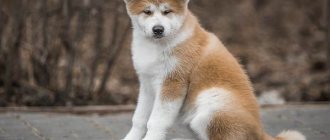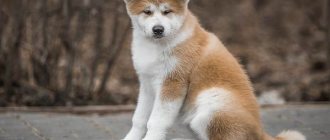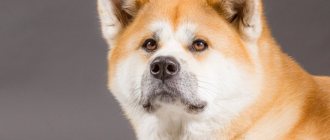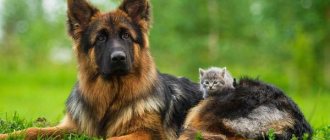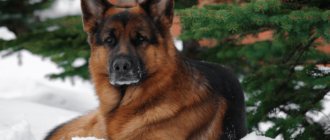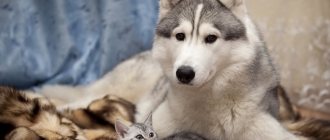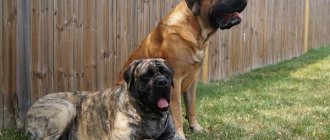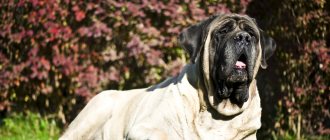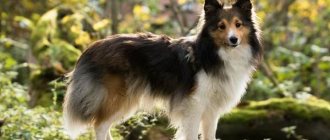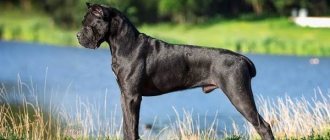Akita Inu is the most popular Japanese breed. It has been known in its homeland since ancient times. The world learned about the breed in the 20th century. She immediately attracted the attention of breeders and became popular. This dog is smart, strong and loyal. Capable of becoming a loyal friend and companion, watchman or security guard. But her character is complex, she is willful and independent. Therefore, everyone who is attracted to this breed needs to study its description, pros and cons, and reviews from owners. A photo of Akita Inu dogs shows what they look like:
- Head
- Attitude towards children
- Hygiene procedures
History of the Akita Inu breed
According to information from ancient historical sources in Japan, the ancestor of modern representatives of the breed is the Matagi Inu (Matagi is an ethnic group of hunters, inu is “dog”).
The region of origin of the Akita Inu is considered to be Akita Prefecture on the island of Honshu. Matagi Inu and her ancestors served people as indispensable hunting assistants, allowing them to hunt even very large or agile animals: Japanese macaques, bears, wild boars. In the 12th-13th centuries, a new popular entertainment arose in Japan - dog fighting. It became a cruel selection for these dogs, leaving only the strongest, most evil and hardy. In the 19th century, a wave of industrialization swept across the country, many residents moved, and the number of crimes increased. Because of this, the Matagi Inu were retrained to guard property. At the same time, bullmastiffs, mastiffs, and Great Danes were brought from Europe to Japan, reviving the tradition of dog fighting. Increasingly, Akitas were crossed with these dogs to produce more aggressive and larger dogs.
This caused concern among Japanese dog breeders, because the breed began to lose its features, so in 1931 the Akita Inu was transferred to the status of a natural monument at the state level. Breeders are actively engaged in reviving the breed, selecting only the best representatives for breeding. The first official standard was introduced in 1934, but over time it had to be adjusted. Around the same time, the breed received its modern name, and in 1967 a thematic museum was opened.
The Akita Inu suffered serious damage during World War II - these dogs almost disappeared. They suffered from hunger, became victims of barely surviving people, their skins were used for clothing. At the end of the war, a government decree was issued to exterminate all dogs unsuitable for military purposes, since a real rabies epidemic had begun in Japan. For this reason, breeders hid some representatives of the breed in remote settlements, breeding them from the Matagi Inu. Hobbyists also bred hybrid generations of Akita and German Shepherd to adapt them for military service.
After the war, a new round of restoration of the Akita Inu breed began, the greatest contribution to which was made by Morie Sawataishi - it was thanks to him that these unique dogs have survived to this day. Purebred individuals had to be collected all over the country, but it paid off. The American military liked the charming and proud Akita, so the breed was brought to the United States.
Kai
The Kai (also brindle dog or tora) is another native Japanese dog breed listed in the Nippo registry. This is a medium-sized dog (45–50 cm and 11–25 kg). It is distinguished by black spots on the tongue and brindle color: pure, with a predominance of red or black.
The endurance, agility and courage of the breed allow the Kai Inu to be used as a universal hunter. It copes equally well with any game: from pheasants to bears. But today, Torah is more often taken as a companion.
Brindle dogs are amazing. They become strongly attached to their owner and selflessly protect him, cannot tolerate family changes, and with proper socialization they get along well with other animals and strangers. They are also clean, smart, independent, excellent swimmers and able to climb sloping trees.
Kai is a rare breed even in Japan. No more than 900–1,100 new puppies are registered per year.
Features of the American Akita
The American branch of this breed appeared precisely after World War II, when US military personnel began to export puppies to their homeland. It is interesting that they were mainly interested in large mestizos, somewhat similar to bears, and not purebred dogs. This played into the hands of Japanese dog breeders, who did not want to share the laboriously recreated breed.
Selection experiments continued in the USA, where they managed to obtain more massive dogs with a menacing appearance - which is why we now have two varieties of the breed with significant differences. The Americans managed to gain recognition from the AKC (American Kennel Club, an organization that registers purebred dogs and new breeds) only after refusing to import new dogs from Japan. This led to a severe limitation of the gene pool, and therefore the development of the breed as such. The Japanese continued to work on colors, since they had a large variability of genes at their disposal. Today, the Akita Inu is considered a good companion, a devoted protector of the owner and his property.
Hokkaido
The second name of this breed is Ainu, and in appearance it resembles a Spitz. These are very ancient, rare and valuable dogs, ideally suited for mountainous terrain and difficult living conditions. She was not specially bred, which means that the main features of her appearance and character were formed under the influence of natural selection. Hokkaido are very brave, decisive and have good sense of direction in new terrain or unfamiliar situations.
Photo: funart.pro
The most beautiful dog breeds: names and photos (catalog)
Appearance and special features of the breed
The Japanese version is called Akita Inu - these are medium to large sized dogs with a dense, at the same time graceful physique. The head with small ears resembles a fox. Only a few color options are recognized. The fur must be short and there must be a white mask on the muzzle.
The version from the USA is called the large Japanese dog or American Akita. They are exceptionally large dogs with heavy bear-like heads. Almost any variant of suit is recognized, including black or with a dark mask.
general description
Akita Inu thrives in moderate to cold climates. Among the characteristic features:
- fairly large head;
- erect triangular ears;
- strong physique;
- tail curled into a donut.
An adult male has a height of 66-71 cm at the withers, weight from 45 to 59 kg. Females are 61-66 cm tall, weigh from 32 to 45 kg, while their body length is slightly longer than that of males. The Japanese version of the breed is slightly lighter and smaller. Eight-week-old puppies usually have the following parameters:
- large Japanese - weight 8.16-9.97 kg;
- Akita Inu – weight 7.25-9.07 kg.
The growth of dogs is slow; the animal’s development finally ends only by 3 years. Puppies gain weight quite actively (up to 7 kg per month); after reaching 35-49 kg, their development slows down greatly, but does not complete until the age of three. Don't worry if your pet doesn't quite fit into existing growth charts as these are very general guidelines. In general, the dynamics are as follows:
- 6 weeks – the puppies are large and very charming, little like adult dogs;
- 6 months – body proportions change, the dog becomes more toned, the puppy roundness disappears, characteristic features are more clearly defined;
- 1 year – bitches begin to heat, but they cannot be considered adults;
- 1-2 years – the growth process slows down greatly, but the transformation of the body continues, especially in the head area;
- 2 years – the dog stops growing in height, expands slightly in width, small changes will continue for another year.
Wool
The classic standard is a dense short coat (about 5 cm), which is slightly longer on the neck and tail. The coat is erect, made of coarse guard and needle-like hairs, the undercoat is very thick and downy. Akita Inu can only have this color:
- pure white;
- red with white fragments and mask (urajiro);
- brindle, also with urajiro;
- red with black tips of hairs (sesame).
The American Akita comes in any color. Long-haired dogs are often born - this is a consequence of a combination of recessive genes from the father and mother. They are the same in character, but do not fit into the standard, therefore they are considered a reject.
Ears
In puppies, the ears are drooping, while in adult dogs they are erect, facing forward and slightly to the sides. They do not accept this position immediately, and this is influenced by two factors:
- age - only as you grow older and strengthen the special muscles, the ears will begin to rise. Chewing and gnawing on toys can speed up this process;
- change of teeth - until permanent teeth appear in place of milk teeth, the ears will not rise completely.
It often happens that they fall back or only one ear is erect. This process takes from 10 weeks to 6 months, so there is no need to worry until six months - the position of the ears will level out.
Eyes
The eyes are brown (preferably as dark as possible), small, deep-set. They have a triangular "oriental" shape that is noticeable from birth. For dogs of light color, black “eyeliner” is allowed, which only emphasizes the special cut.
Tail
In purebred dogs it is fluffy, thick, and rolled into a tight ring. Babies have a straight tail that curls during the first 2 months of life. If the dog is sleeping or just relaxed, it may unwind slightly, but it never becomes straight. Visually and to the touch, this part of the body does not change even during the molting period. The fluffy “donut” tail seems to balance the pet’s large head.
Paws
The description of the paws differs little for different standards: straight, arched, with thick pads, similar to a cat's. Both varieties of Akita have tightly closed toes, which gives them the ability to swim well. In this case, not only the forelimbs are involved, but also the hind limbs. However, most dogs of this breed do not like to swim, entering the water only when absolutely necessary.
Dogs popular in Japan
Japanese cities are beautiful, but very cramped. It is not surprising that decorative breeds and small companions are popular there. the Shibu Inu and the Japanese Chin as pets . Those who can afford a relatively large pet buy either an Akita or a retriever . The most common breeds among dog owners are the intelligent and friendly Labrador Retrievers and Golden Retrievers .
Shitzu
The miniature fluffy beauty did not appear in China, her homeland is Tibet . But it was from China that the fashion for shitsu came. The weight of the dog can reach 8 kg, and its height is 27 cm. Shitsu has very long, variegated fur relative to the body (black individuals are occasionally found, a little more often white). This is a cute little companion. The Leo dog loves people (especially children), and is friendly, affectionate and playful. The long fur of such a pet requires constant care.
Bolonki
This is a group of decorative dogs. In Japan, they value the snow-white, curly-haired Bichon Frize (they are active, affectionate, cheerful pranksters), the shaggy Bolognese, and the charming Maltese. Their light fluffy coats require care, and the dogs themselves crave the attention of their owners; they are sociable, cheerful and playful.
Chihuahua
The smallest dogs in the world. Their weight does not exceed 3 kg . Both smooth-haired and long-haired individuals are common. These are active, energetic, curious and intelligent pets. Chihuahuas need to be protected from the cold, and they often have allergic reactions to food, household chemicals and even their owners’ perfumes.
Dachshunds
Hunting dogs, the oldest burrow dogs. An ordinary dachshund, according to the standard, reaches a weight of up to 9 kg , miniature and rabbit ones are noticeably smaller: 5.5 kg. and 3.5 kg. respectively. These are very smart, brave and balanced animals. They are hardy, independent and loyal. Owners need to monitor the health of their pet’s back and not overfeed it.
Toy poodle
A charming baby weighing no more than 5 kg. The Toy Poodle is friendly, active and highly trainable. This is a human-oriented dog with thick curly hair. He does not shed and is classified as a hypoallergenic pet. This pet is friendly to other animals and willingly plays with children.
Sheltie
A medium-sized herding dog (weight - up to 11.5 kg, height - up to 39.5 cm in males and up to 38 cm in females). Due to its small size and attractive appearance, it is popular as a pet rather than a working dog. The Sheltie is well trained and loyal to other pets. She is smart, active and loyal.
Akita Inu character
It is difficult to briefly describe the character of this breed. Akitas are very versatile dogs. The American subspecies is distinguished by more serious habits, the Japanese are somewhat more playful and frivolous. At the same time, most representatives of the breed are not stupid sofa pets or overly gloomy dogs. There are several main character traits.
- Own independent thinking - this is often mistaken for stubbornness, but in fact it is enough to establish mutual understanding.
- The sense of hierarchy is very developed, so they try to establish a rank in relation to the owner’s other dogs. It is important to achieve recognition of the person as the leader within the first weeks and months of the dog’s life, otherwise he will dominate.
- Trainability – Akita Inu dogs quickly grasp new knowledge and skills, so they begin to get bored if they repeat the same thing for a long time. It is very important for them to understand why they perform certain tasks, so it is worth taking care to develop the right motivation.
- No fear of heights - it is worth blocking off the balcony and other dangerous places, because puppies are very brave and not too smart. Adult dogs jump high, caring little about where they land.
- Craving for space - they like to run a lot, frolic in nature, and visit new places. Physical activity is vital for them.
- Tenderness – mentally these dogs are very sensitive, they are easily offended.
- Loyalty to the owner - the Akita will not pester or interfere with everyday activities or recreation, but they are very loyal creatures. They love to quietly follow their owner everywhere.
- Patience – despite being dominant, a properly trained dog is incredibly patient. She will modestly wait for you from work or sit quietly by the bed, waiting for you to wake up.
- Attitude towards other people - Akita gets along well with older people. The attitude towards children depends on their behavior and family affiliation.
- Attitude towards dogs - if the other dog is smaller and lives in the same family, there will most likely be friendship. Relationships with representatives of the same species and the same sex, completely alien dogs, are difficult. Aggression (at least in the form of growling) is especially active if the second pet is of the same or larger size.
- Fear of small spaces – Akita Inu dogs do not like too cramped enclosed spaces. They try to get a good view and control of the space.
- Aggression – these dogs are very sensitive to the relationship between guest and owner. Welcome visitors need not worry. Such dogs do not like strangers, so they will closely watch the guest until they understand how appropriate his presence is in the house. Only proper training will help manage innate aggression.
- Security - they are good guards, but they do not immediately rush to bite. For example, they will simply try not to let a thief leave the house, waiting for the owner’s help.
- Barking dogs are fairly quiet dogs, but they are very sensitive to new people, animals and sounds, and are able to use their voice to issue a warning to someone who is invading their territory.
Dog handler's opinion
Expert opinion
Kozhevin Semyon Kirillovich
Expert dog handler.
“The Shiba Inu is a representative, albeit similar to the Akita, but still a different breed. These are medium-sized dogs, mostly bright red in color, distinguished by a bold, but at the same time balanced and calm disposition, intelligent and friendly towards their owners. They are better suited for living in an apartment than their larger “relatives,” but you need to remember that these dogs need significant physical activity.
It’s not difficult to keep a mini Akita, but you need to take into account that these dogs need a special diet, since during the long isolation in their historical homeland, the Shiba Inu has developed special taste preferences.”
Care and maintenance
Despite its dislike for confined spaces, the Akita Inu is well suited both for living in a city apartment and for keeping in a private house. In any case, it is extremely important to provide long walks during which the dog can realize his energy. Start exploring the world around you after completing all vaccinations.
- Walk around the area and beyond, change routes every day.
- Visit both quiet and noisy places so that the dog gets used to as many situations as possible (park, forest, shops, beach, market, pet store, square). In the future, when she gets into a crowded place, she will not experience serious stress.
- During walks, keep your Akita on a leash, showing leader control.
- Although this breed does not like other dogs, teach them to behave calmly. When meeting another pet on a leash, let them get to know each other and sniff each other. If everything goes well, don't interfere. If aggression or growling occurs, separate the dogs.
- Teach your dog to travel in the car - start with trips of 5-10 minutes a day, gradually increasing this time to 35-45 minutes.
Nutrition
Make sure your dog does not gain excess weight. Being overweight is fraught with impaired digestive function, body asymmetry and poor health. For an adult representative of the breed in question, the daily dose of food is 600 grams. Give him the opportunity to eat twice a day, for example at 9 am and in the evening, closer to sunset.
The younger the dog, the more protein it should consume daily. Feed her dairy products, raw meat and cereals boiled with vegetables. It is advisable to add special vitamins to your dog’s food. We recommend that you consult your veterinarian first. He himself will select the supplement your pet needs.
Advice! The best complementary food for purebred dogs is bone meal. This is a very useful product, the use of which will significantly improve their health.
Akita Inu puppies , like adult representatives of the breed, can eat dry food. But, it is advisable to dilute their diet with natural food. Recommended products: cottage cheese, chicken eggs, turkey, buckwheat, bananas, etc. But you can’t give them smoked meats and dishes with spices.
Features of care
Akita Inu sheds heavily twice a year: from January to February and from May to June. During this period, the dog must be brushed every day or at least 3-4 times a week. The rest of the time, brushing 4 times a month is sufficient. Constant shedding is possible in a house with very warm and dry air. Another reason is illness or poor diet. There is no need to cut or trim your pet's coat. There are other care recommendations.
- Bathe your dog no more than 1-2 times a year so as not to wash off the special protective lubricant of the coat. These dogs are very clean themselves, they know how to lick themselves, and the rest of the dirt will be removed during brushing.
- Brush your pet's teeth 1-2 times a week. Use only a special product.
- Regularly examine your Akita's eyes and ears to notice inflammation, discharge or an unpleasant odor - all this indicates the need to urgently visit a veterinarian.
- Trim your nails every month if they don't wear down naturally.
Accustom your dog to any procedures while still a puppy. You may simply not be able to cope with an older dog or it may cause stress and loss of trust.
How does he relate to children, does he get along with pets?
If Akita Inu can keep a distance with adults and be emphatically respectful, then with children it is as if she returns to childhood - she loves and can play with them for a long time and spend time. This is not without reason - the Japanese elite often used their pets as nannies for children .
If there are other smaller breed dogs or cats in the house, the Akita Inu will get along well with them, especially if they have been raised together since childhood. If a dog of the same breed or size appears in the house, it will be important for the Akita Inu to establish dominance in the first few weeks.
Akita Inu Health and Diseases
This breed is in good health, provided that the puppy does not have any serious congenital defects. Sometimes they suffer from genetic diseases and are sensitive to certain medications. Among congenital and acquired/age-related ailments there are:
- entropy (inversion of the eyelid);
- hip dysplasia;
- bloating;
- glaucoma;
- cataract;
- pseudoparalytic myasthenia (weakness of all muscles of the body);
- von Willebrand disease (blood pathology);
- retinal atrophy.
Kishu
Kishu is another ancient breed from the Land of the Rising Sun, recognized as a national treasure. It has the typical external features of Japanese breeds: a triangular head, pointed erect ears, a curved tail and double coat. The color is most often white, but there are also representatives with a red or zone color.
Kishu is a rare breed. There are not many dogs even in Japan: about 11–13 thousand. And outside the country they are generally difficult to meet.
Despite their average size (49–52 cm), kishu are fearless hunters of large animals. They bravely drive bears and wild boars, hold them until the hunter arrives, jumping onto the back of the prey and clinging to it with their teeth. Pets can also guard the territory or herd livestock.
Kishu are unpretentious and can live in the harshest conditions. They don't care about heat or cold. But minimal care is needed: washing once every couple of months, weekly brushing, brushing teeth and ears, and trimming nails as they grow.
Breeds of white dogs with names and photos.
How to choose a puppy
You can buy purebred puppies only from large, reliable breeders. The main signs of a healthy Akita Inu baby:
- active and cheerful;
- puppy of average fatness;
- beautiful shiny coat;
- runs confidently, stands firmly on its paws;
- not aggressive, not afraid of loud sounds.
Pay attention to the color and shape of the Akita Inu's eyes - if they are round and light, this is not a purebred pet. Features of the shape of the eyes are necessarily congenital, and the color changes with age only to a lighter color. The bite must be correct, the pigmentation of the nose and mouth must be uniform. If you buy a puppy older than six months, and its tail has not yet curled, this is a bad sign. If you plan to participate in competitions and exhibitions, then it is better to choose a baby with an experienced dog handler. When purchasing an ordinary pet, it is enough to use the criteria outlined above.
Hin
The tiny toy breed, weighing about 3 kg, is one of the oldest breeds in Japan. Chins can live in absolutely any room, but are not at all adapted to the street. Such dogs are easy to train, but cannot tolerate boredom, so you will have to try to choose more interesting tasks.
Photo: krasivosti.pro
Did you like the post? Subscribe to our channel in Yandex.Zen, it really helps us in our development!
Japanese Terrier
This breed is the only one of the terrier group bred in Japan. Their breeding began at the beginning of the 20th century. The goal was to get a decorative dog that would easily adapt to life in densely populated cities.
During breeding, Italian Greyhounds, Smooth Fox Terriers, Manchester Terriers and small aboriginal dogs were crossed. The result was a miniature dog (30–33 cm and 2–4 kg), with a compact body, long legs and very short hair (up to 2 mm).
The Japanese Terrier is easily distinguished by its unique tricolor coat. The head is decorated with a black mask with red and white spots, and on the light body there are dark or reddish-brown markings.
The Japanese Terrier is an excellent dog for an apartment and a family. He is friendly, playful, and gets along with children. However, it can chase cats and rodents, and is wary and somewhat cowardly with strangers. The dog is also easy to care for: weekly brushing with a soft brush and occasional washing are enough. The only thing is that the pet cannot stand the cold, so from autumn to spring you will need clothes.
On topic: Varieties of terriers
Color variations
According to the standard, only three colors are allowed in Akita Inu.:
- Ginger.
- Brindle.
- White.
With any of them, with the exception of white color, the dog must have “urajiro”: lightening to white on the inner surface of the paws, belly, chest, neck, tail and muzzle.
Black Akita Inus are also found.
The nose, edging of the eyelids and lips should be pigmented black or brown (acceptable for white dogs).
Learning ability
Akita Inu easily adapt to living conditions and are trainable. Rumors about their stubbornness and destructive behavior appear more likely due to incorrect actions of trainers, reinforcing undesirable behavior during classes.
Akita Inu training rules:
- Form desirable behavior from the moment the puppy arrives in the house. Observe discipline strictly - persistently and patiently explain to the puppy exactly what actions are unpleasant to you.
- Prevent dominance on the part of the dog. Akita gets excited in an unusual situation, demanding the owner's attention, and in moments of boredom, it barks and whines. This behavior should be stopped by providing the dog with sufficient exercise and requiring commands to be followed. If security qualities are undesirable, stop their manifestation.
- Conduct training consistently, bringing each command to automaticity and only then introducing a new one.
- Be tougher than a dog. Having driven her out of bed once, patiently repeat the procedure every time the Akita jumps onto the bed. If you expose him to unwanted behavior once, the dog will feel like a leader and will manipulate the owner.
- Understand the dog’s way of thinking and demand only doable things from it.
- Reinforce positive actions with a treat or game - always!
- Take breaks if the dog is tired. But do not confuse fatigue and the desire to cheat.
- The strength of punishment should be chosen in accordance with the offense. Hitting the dog is prohibited!
You need to react the same way to the same actions. If today you were happy when a dog jumped into your arms, and tomorrow you forbade it and cursed, it ceases to understand what is true.
Sakhalin Husky
The Japanese call Sakhalin or Gilyak Laikas Karafuto-ken. Initially, the breed originated in the Amur region and Sakhalin. But in the 30s of the 20th century they were purposefully exterminated in their homeland. At the same time, the dogs were taken to Japan, where they were revived.
Sakhalin Huskies are considered an endangered breed. Work is still underway to restore and increase the number.
Sakhalin residents are sled dogs. They were also used to bait bears and sea animals. They are smart, brave and very resilient. In terms of working qualities, they are superior to Siberian Huskies, Malamutes and other breeds.
The breed went down in history thanks to an amazing incident. In 1958, Japanese researchers had to leave 15 Sakhalin huskies in Antarctica. Scientists expected to pick them up soon, but due to worsening weather they were able to return only a year later. Surprisingly, people found two surviving dogs. In honor of them and the dead dogs, a monument was erected in Japan, and two films were made: “Antarctica” and the American remake “White Captivity”.
Sanshu
The Sanshu is another ancient Japanese dog breed that was lost and revived by enthusiasts in the early 20th century. Her ancestors accompanied the emperors, protecting their lives and protecting their peace. And today pets are excellent watchdogs, faithful companions and devoted family members.
Sanshu is a rare breed, almost never found outside of Japan. Also, it has not yet been recognized by major canine organizations.
Sanshu is distinguished by its medium size (41–46 cm and 20–25 kg), a fox face, triangular ears and a tail thrown over the back. The color is varied: white, red, brown, tan, black, gray or pepper and salt.
Sanshu are unpretentious. They can live in a house or apartment, and hygiene procedures require periodic brushing, bathing, and examination of ears and teeth. The main thing is to pay attention to nutrition and disease prevention. If you take proper care of your pet, he will live to be 15–17 years old.
Types of crossbreeds
The most popular Akita Inu mixes:
- Akita Inu + German Shepherd . They make good dogs for families with children, as they are good with kids. However, a crossbreed with a shepherd is distinguished by a stubborn character and needs proper education and socialization, and when training it, the best method would be an individual approach to training.
- Akita Inu + Husky (Haskita) . The physique is almost the same as that of an Akita, although the frame may be a little lighter. These mestizos are distinguished by great energy and mobility. They are incredibly purposeful and stubborn.
- Akita inu + husky . These dogs have a slightly lighter build than the Akita Inu, and they are distinguished by a rather ardent temperament and energy. They also usually have a well-developed hunting instinct.
- Akita Inu + mongrel . The most unpredictable combination of all possible, since an outbred parent can contain an innumerable variety of different bloods. The character and appearance of such a pet depends on who its ancestors are.
Mixed dogs are a kind of lottery, because it is impossible to predict how the genes will play out and what features of appearance, temperament and character the puppy will inherit.
